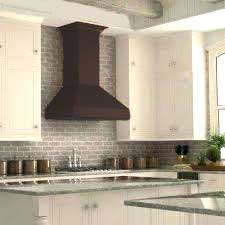In faulty construction practices when building or  remodeling a kitchen, unskilled or unqualified contractors can vent the kitchen hood improperly, which could potentially create a fire or other hazardous condition. Here are the kitchen hood venting requirements you, as a homeowner, should be aware of.
remodeling a kitchen, unskilled or unqualified contractors can vent the kitchen hood improperly, which could potentially create a fire or other hazardous condition. Here are the kitchen hood venting requirements you, as a homeowner, should be aware of.
Kitchen Hood Venting Requirements
All kitchen range hood vents should terminate outside through the roof or a side wall, not into an attic or other enclosed area. Vents should never be terminated into spaces within walls, ceilings, crawl spaces or garages.
Vents should be made of metal or aluminum only, with a rigid metal vent recommended. Plastic vents should never be used. Ducts should be as straight as possible with requirements for use of elbow joints if they are needed. They are also required to have a self-closing flapper on the outside vent to protect against rodents and other pests.
All connections should be secured using metal screws and either certified Silver Tape or Duct Tape should be used to tape all joints. The exterior wall seal should be caulked around the cap.
See PDF for venting requirements.
Code Violation and Hazards for Kitchen Hood Venting
Failure to properly vent a kitchen is a building code violation. In addition, improper stove hood exhaust venting can cause these problems to occur:
- Grease buildup: Exhaust vented from a kitchen hood contains small particles of grease which can create a buildup of grease residue within the attic, creating both a fire hazard and a lure for pests.
- Fire hazard: If a fire should occur on the stovetop, it could be carried by the exhaust fan into the attic or enclosed space. If a gas stove is leaking, the gas can be exhausted into the closed space, creating a buildup and potential fire or explosion hazard.
- Excess moisture: Steam created by cooking can be vented into enclosed spaces, which can create wood rot, mold and mildew problems in structural elements and insulation.
- Gas Buildup: A gas stove or oven can give off water vapor and other gasses including carbon monoxide (CO2) that should be vented to the outside atmosphere.
Related: 2018 Residential Code/Exhaust
You can perform a visual check to ensure that your kitchen hood venting terminates to the exterior of your home. Or contact Först Consulting Group to perform a kitchen hood venting inspection, or a whole-house inspection.
For a Code Violation Inspection, contact Först Consulting Group
Private inspections are helpful when you are building a new home or remodeling an old one. This is your way, as the homeowner, to ensure that the contractor’s work is up to code. We keep up to date on current building code requirements, and understand defects caused by inexperienced workers or faulty construction practices.
As part of our homeowner services, Först Consulting Group can provide construction defect and construction error inspections, building pathology inspections, pre-drywall inspections and stucco inspections, to name a few. You don’t have to rely on the contractor when you have Först on your side. Contact us today.




